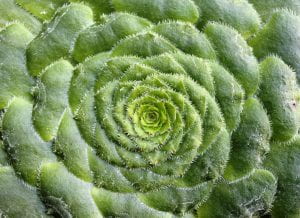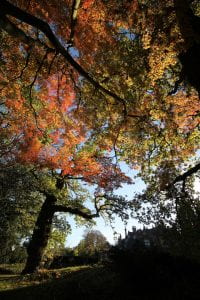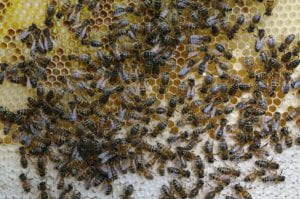By Andy Winfield
 It was Georgia O’Keefe who said, ‘When you take a flower in your hand and really look at it, it’s your world for the moment’. It’s worth doing this, nature is captivating close up; perfectly packaged and clinically efficient, each flower has an adapted shape and look gleaned over hundreds of thousands of years for maximum productivity. This economy of engineering uses patterns and shapes that are repeated again and again throughout the natural world and dotted all around the Botanic Garden.
It was Georgia O’Keefe who said, ‘When you take a flower in your hand and really look at it, it’s your world for the moment’. It’s worth doing this, nature is captivating close up; perfectly packaged and clinically efficient, each flower has an adapted shape and look gleaned over hundreds of thousands of years for maximum productivity. This economy of engineering uses patterns and shapes that are repeated again and again throughout the natural world and dotted all around the Botanic Garden.
 A person whose observations became his whole world was Leonardo Da Vinci; his theories were well ahead of their time such as his 500 year old ‘tree rule’. He noticed that when tree branches divide, the diameter of the two new branches when put together are the same as the original branch. As branches get smaller the pattern is repeated all the way down to twigs; so, if you were to pick any height up a tree the total cross section of each branch at that elevation would be equal the cross section of the trunk, never more and never less. For many years scientists felt this was an adaptation to affect an easy journey for fluid to the leaves, but recent computer simulations have found that these patterns create the most wind resistant structure a tree can be. In 1887 Eiffel designed the tower that now dominates the Paris skyline; his inspiration for a construction best able to resist high winds was trees, and more specifically Da Vinci’s tree rule.
A person whose observations became his whole world was Leonardo Da Vinci; his theories were well ahead of their time such as his 500 year old ‘tree rule’. He noticed that when tree branches divide, the diameter of the two new branches when put together are the same as the original branch. As branches get smaller the pattern is repeated all the way down to twigs; so, if you were to pick any height up a tree the total cross section of each branch at that elevation would be equal the cross section of the trunk, never more and never less. For many years scientists felt this was an adaptation to affect an easy journey for fluid to the leaves, but recent computer simulations have found that these patterns create the most wind resistant structure a tree can be. In 1887 Eiffel designed the tower that now dominates the Paris skyline; his inspiration for a construction best able to resist high winds was trees, and more specifically Da Vinci’s tree rule.

Leonardo Fibonacci was a mathematician who was born in 1170 in Italy; his name is attached to one of nature’s most prominent patterns, the Fibonacci spiral also known as the Golden Ratio. Bear with me on this… Fibonacci’s sequence is a series of numbers, each number is made up by adding together the previous two numbers; 0, 1, 1, 2, 3, 5, 8, and so on. Now, imagine each of these numbers represented a series of squares (1×1, 2×2, 3,3 etc) arranged so that each new square makes a rectangle with the last; draw a curve through each square and you have yourself a Fibonacci spiral. The ratio of each rectangle to the previous one is known as the Golden Ratio, as a number it is 1.618 or phi, the divine number. This concentric pattern and ratio appears everywhere in the plant world from flowers to leaf growth to pine cones and tree growth; it appears in tiny sea shells at the bottom of the ocean and huge galaxies light years away in outer space, it is the ratio between female bees to male bees in a typical hive and it also it also appears in us; our total height divided by the height of our torso should come to the golden ration 1.618.
Another pattern appearing in nature is the hexagon. The cells of a beehive  are, of course hexagonal but are built by the bee as a tube; as the wax warms and cools it falls in with its neighbours and the straight edges of a six-sided hexagon are formed. This shape is an incredibly efficient use of space and appears everywhere, in the eyes of dragonflies and the skin of fruit; carbon atoms, which are present in all living organisms, when bonded with others make a perfect hexagon. So, without the hexagon there would be no us!
are, of course hexagonal but are built by the bee as a tube; as the wax warms and cools it falls in with its neighbours and the straight edges of a six-sided hexagon are formed. This shape is an incredibly efficient use of space and appears everywhere, in the eyes of dragonflies and the skin of fruit; carbon atoms, which are present in all living organisms, when bonded with others make a perfect hexagon. So, without the hexagon there would be no us!
Patterns are all around us in the natural world, I would thoroughly recommend taking Georgia O’Keefe’s advice when you have a moment, there’s a whole lot going on in those flowers, make it your whole world for a minute or two.

